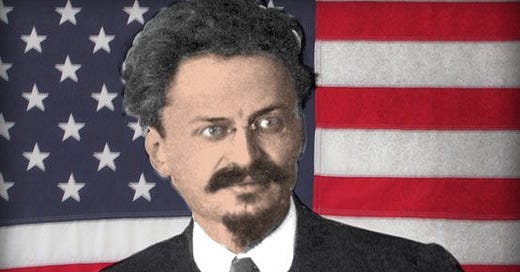The Trotskyist Century
In The Jewish Century, Yuri Slezkine offered an audacious metaphor: the modern age belongs to the Jews not simply because of their disproportionate influence, but because the Jewish condition—urban, diasporic, adaptive, and intellectual—became modernity’s condition. If Slezkine recast Jews as “Mercurians” in a Promethean world, then the forgotten genealogy of American radicalism requires its own symbolic archetype. In this frame, American Trotskyism—embattled, migratory, hyper-intellectual, utopian—is the lost center of the 20th century.
What if we were to read the past century not as an epic struggle between totalitarianism and liberal democracy, but as a triangle? Soviet Bolshevism on one side: statist, iron-willed, collectivist. American Liberalism on the other: individualist, pragmatic, bourgeois. And in the middle, striving toward synthesis or perhaps eternal exile, sits American Trotskyism—cosmopolitan, marginal, prophetic. In middle point between the Jewish Century and the American Century there was the Trotskyist Century.
American Trotskyism was forged in opposition to both dominant ideologies of the century. Unlike Stalinists, Trotskyists denounced repression, bureaucracy, and the cult of personality. Unlike American liberals, they rejected capitalism’s promise that freedom could coexist with exploitation and racial apartheid. They demanded a world that was both egalitarian and free—and found themselves exiled from both left and right for it.
This exile, paradoxically, gave them clarity. From the margins, they saw what others missed. They exposed the Moscow Trials, denounced the Molotov-Ribbentrop Pact, criticized Jim Crow while liberals looked away, and saw U.S. imperialism not as an accident but as a structure.
From Max Shachtman to Irving Howe, from Hal Draper to Joseph Hansen, the Trotskyist movement in America was populated by sons and daughters of Yiddish-speaking immigrants, garment workers, and autodidacts. These were people for whom Marxist theory was not a foreign import but a native tongue. For many, Trotskyism became a kind of secular Judaism—a rigorous, demanding faith in justice and critique.
But the legacy of Trotskyism is a story not just of idealism, but of strange metamorphoses. Nowhere is this clearer than in the trajectory from the Bronx reading groups of the 1930s to the corridors of power in the 2000s.
The intellectual fathers of American neoconservatism—Irving Kristol, Norman Podhoretz, and others—began their political lives on the far left, often in or around Trotskyist circles. Their early education came not in the seminar rooms of Harvard, but in debates about factional splits within the Socialist Workers Party (SWP). These were men who learned to see history as a battleground of ideas and to believe in the power of ideology to change the world.
They would later turn right, horrified by the New Left’s embrace of anti-Americanism, frustrated by liberalism’s ambiguity, seduced by the promise of moral clarity. But the style of thinking they carried into the neoconservative project—the missionary zeal, the dialectical structure, the belief in global struggle—was Trotskyist in its architecture.
But the content changed. The revolution gave way to Reaganism; the international proletariat was replaced by Pentagon primacy. Trotsky’s theory of “permanent revolution” was inverted into a theory of “permanent war”—from Kabul to Baghdad.
Bernie Sanders, the icon of 21st-century American democratic socialism, has roots—however faint—in the Trotskyist tradition. As a young man in the 1970s, Sanders had associations with the Socialist Workers Party. He spoke at their events, read their papers, and moved in their orbit, even if he never formally joined.
The SWP in that era was still animated by the old spirit: anti-Stalinist, internationalist, committed to labor and civil rights, suspicious of both Democratic liberalism and Soviet authoritarianism. Sanders eventually carved a more pragmatic path, but the moral urgency, the class politics, and the suspicion of American exceptionalism that define his worldview bear Trotskyist fingerprints.
It is no accident that Sanders, like many early Trotskyists, came from a Jewish, working-class background in Brooklyn. Nor is it surprising that his campaign resonated not just with workers, but with the children of immigrants, the downwardly mobile middle class, and a generation that grew up between political worlds.
If Trotskyism never conquered Washington, it did conquer bookstores. Several influential American publishing houses owe much to Trotskyist tradition from Monthly Review to Verso Books to Haymarket Books.
It is easy to mock Trotskyists as sectarians or romantics. And certainly, the movement’s history of endless splits and doctrinal wars can feel more Talmudic than tactical. But its moral stubbornness, its refusal to “choose a side,” made it the century’s necessary conscience.
Trotsky once described himself as a “revolutionary without a country.” That description applies to American Trotskyism as a whole. It never ruled, but it never surrendered. In a way Trotsky himself became the Jewish prophet of a Christian country, the prophet of the American Century.
In retrospect, Trotskyism was not just a political doctrine—it was a condition. To be a Trotskyist in the 20th century was to inhabit contradiction. It was to believe in revolution, but not repression. To defend socialism, but not the state. To speak of the masses, but never speak for them. It was, in a sense, to be modern.
That condition has not disappeared. We see it in climate movements that reject both corporate greenwashing and authoritarian eco-statism. We see it in tenants’ unions, teachers’ strikes, and grassroots internationalisms that reject both nationalism and neoliberalism. We see it in Jewish radicals who, like their forebears, ask not for assimilation into power, but for a new kind of justice.
American Trotskyism was always a politics of in-betweenness—between East and West, revolution and reform, despair and utopia. It never achieved state power, but it shaped the moral compass of the American radical imagination.



